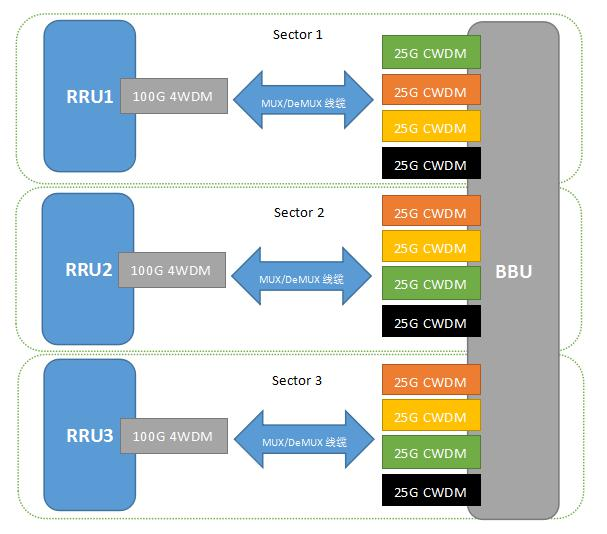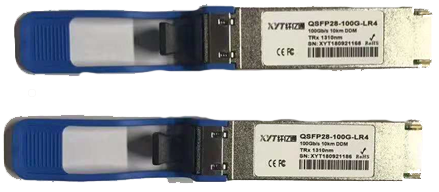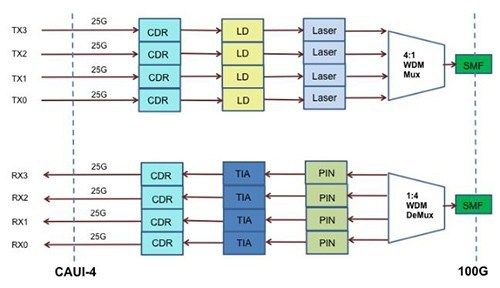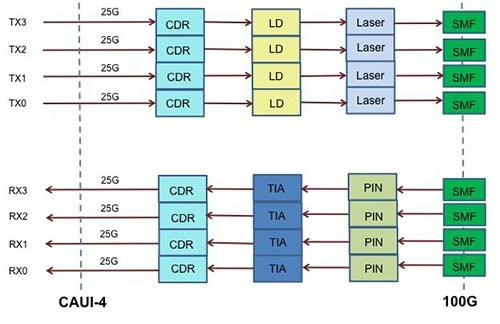
Compared with 4G, the spectrum bandwidth used by 5G has increased rapidly. The upper limit of spectrum bandwidth used by 4G is 20MHz, while that used by 5G in low-frequency band is 100MHz, and that used by 5G in high-frequency band (millimeter wave) is 800MHz, with the upper limit up to 1GHz. At present, 5G high frequency band (millimeter wave) data processing and transmission with large bandwidth still have some difficulties.
Considering the smooth evolution of 5G equipment
and the development of industrial chain, Sharetop Technology has launched 100G
QSFP28 4WDM & 25G SFP28 CWDM fan-out 5G pretransmission solution, which can
well solve the 5G millimeter-wave pretransmission problem at the current stage.
In the fanout scheme, one 100G light module is used on the antenna side, and
four 25G light modules are used on the baseband side. There is no need for
additional shunt function of the device to carry out speed matching on both
ends. The antenna side can use 100G QSFP28 4WDM full-service temperature 10KM
module launched by fibre-yidongtechnology, and the baseband side can also use
25G CWDM full-service temperature 10KM module. Through a MUX/DeMUX bridge
connection, the construction of 5G millimeter-wave front load network can be
completed, and the optical fiber resources can be greatly saved.

Figure 1 schematic diagram of system connection
Optical modules play an important role in optical networks and data centers. The optical module consists of optoelectronic devices, functional circuits and optical interfaces. The optoelectronic devices include transmitting and receiving parts. To put it simply, the function of the optical module is photoelectric conversion. The sending end converts the electrical signal into the optical signal, and then the receiving end converts the optical signal into the electrical signal after the transmission through the optical fiber.
As we know, 100G optical modules come in several packaging types, including CFP/CFP2/CFP4, CXP and QSFP28. Among these different 100G packaging forms, QSFP28 optical module has become the main packaging mode of 100G network due to its advantages of high port density, low power consumption and low cost.
Here are two 100G optical modules: 100G QSFP28 CWDM4 optical module and 100G QSFP28 PSM4 optical transceiver module.
100G QSFP28 CWDM4 light module

The 100G QSFP28 CWDM4 optical module is specially designed for optical communication applications that conform to the standards of QSFP MSA, CWDM4 MSA and IEEE p802.3bm. This module converts four input channels of 25Gb/s electronic data into four CWDM optical signal channels and multiplexes them to a single channel for 100Gb/s optical transmission. On the receiving end, by contrast, the module multiplexes 100Gb/s of optical input to four channels of CWDM optical signal and converts it into electrical data of four output channels.
100G QSFP28 PSM4 optical transceiver module

QSFP28 PSM4 products: xyt-qsfp28-100g, four-channel parallel optical transmission, support 100G or 40G Ethernet, Infiniband DDR/EDR. Four data channels are integrated in a total of 104 Gbps bandwidth, each channel 26Gbps, transmission distance up to 2 km using G.652 SMF, using a wavelength of 1310nm for transmission. Electrical interface USES 38PIN Edge connector. The optical interface USES a single mode 12-core MTP(MPO) connector. Sharetop Technology excellent circuit technology and optical technology support module long life, high performance.
So what's the difference between the two?
100G CWDM4

100G CWDM4 is a multi-source protocol (MSA). The 100G CWDM4 optical module introduces WDM technology and adopts a duplex LC interface. When used together with single-mode fiber, the transmission distance can reach 2km.
It is widely used in CATV (cable TV), FTTH (fiber to home), 1G and 2G fiber channels, 100mb and 2G Ethernet, synchronous fiber network SONET oc-3 (155Mbps), oc-12 (622Mbps) and oc-48 (2.488Gbps), security and protection systems and other fields.
100G PMS4

100Gbps PMS4 standard is formulated by MSA group. The standard defines a low-cost solution to interconnect long-distance data centers. With the further increase of data center scale and the improvement of fiber transmission rate, a low-cost scheme that can transmit distances of no less than 500 meters is needed. The 100Gbps PSM4 standard was developed to provide a parallel single-mode infrastructure for the service requirements of the next generation of data centers.
With the gradual development of 5G network construction, Sharetop Technology co., LTD., as the leading optical module manufacturer, will as always provide customers with the best optical communication solutions and help 5G era flourish.
More fibre-optic communications information and dry goods are available in Sharetop Technology